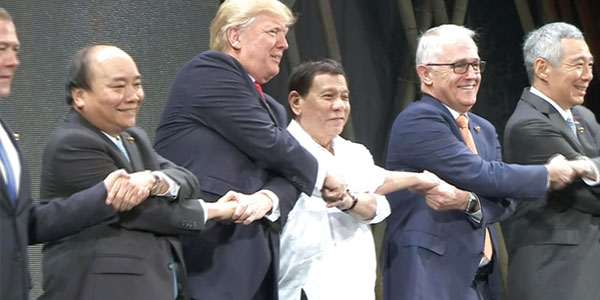
Commentary by Dermidio Juez-Perez
President Trump’s five-nation trip throughout the Asia Pacific region, which concluded on Nov. 14, was intended mainly to accomplish two important objectives for the United States.
First, it was designed to improve U.S. relations with America’s Asian allies. Secondly, it was intended to curb North Korea’s growing nuclear threat. The White House said the president’s trip would “strengthen the international resolve to confront the North Korean threat and ensure the complete, verifiable and irreversible denuclearization of the Korean Peninsula.”
Considering the president’s strong criticism toward many of the countries he visited – China and South Korea in particular – the White House’s strategy was risky. For instance, Trump has accused China of “raping the United Stated through our treaties.” As the president has said before, he doesn’t have a filter and he calls things as he sees them – an extremely dangerous tactic to use while trying to improve international relations.
However, President Trump’ trip went without any major incidents. And considering the administration’s primary goal was to improve relations with Japan, South Korea, China, Vietnam and the Philippines, the trip was an unquestionable success.
A testament to the trip’s success was given by Japanese Prime Minister Shinzo Abe, who told the press: “There has never been such close bonds intimately connecting the leaders of both nations as we do (have) now in the history of (the) Japan-U.S. alliance.” And South Korean leader Choo Mi-ae said during an interview that Trump’s visit had “actually led to an improvement in our bilateral relations.”
Trump’s success originated, perhaps, from his willingness to stick to the script visiting dignitaries are supposed to follow, calmly letting the Asian leaders play the role of hosts. By doing so, it appears he accomplished his first goal. And by accomplishing the first goal, he might have taken a major step toward accomplishing the second one.
_____________________________________________________________________________________________________
El exitoso viaje de Trump a través de Asia
El viaje por cinco naciones del presidente Trump a lo largo de la región de Asia Pacífico, que concluyó el 14 de noviembre, tenía la intención principal de lograr dos objetivos importantes para Estados Unidos.
Primero, fue diseñado para mejorar las relaciones de EE. UU. con los aliados asiáticos de América. En segundo lugar, pretendía frenar la creciente amenaza nuclear de Corea del Norte. La Casa Blanca dijo que el viaje del Presidente “fortalecería la resolución internacional para enfrentar la amenaza de Corea del Norte y garantizar la desnuclearización completa, verificable e irreversible de la península de Corea”.
Teniendo en cuenta las fuertes críticas del Presidente hacia muchos de los países que visitó, especialmente a China y Corea del Sur, la estrategia de la Casa Blanca fue arriesgada. Por ejemplo, Trump ha acusado a China de “violar a los Estados Unidos a través de nuestros tratados”. Como el Presidente dijo antes, no tiene filtro y llama las cosas como las ve, una táctica extremadamente peligrosa que se debe usar al intentar mejorar las relaciones internacionales.
Sin embargo, el viaje del presidente Trump sucedió sin incidentes importantes. Y considerando que el objetivo principal del gobierno era mejorar las relaciones con Japón, Corea del Sur, China, Vietnam y Filipinas, el viaje fue un éxito indiscutible.
Un testimonio del éxito del viaje fue dado por el primer ministro japonés Shinzo Abe, quien dijo a la prensa: “Nunca ha habido vínculos tan estrechos conectando íntimamente a los líderes de ambas naciones como lo tenemos ahora en la historia de (Japón).” Alianza con EE. UU. y el líder surcoreano, Choo Mi-ae, dijo durante una entrevista que la visita de Trump “en realidad condujo a una mejora en nuestras relaciones bilaterales”.
El éxito de Trump se originó, quizás, por su voluntad de seguir el guión que los dignatarios visitantes deben seguir, permitiendo que los líderes asiáticos desempeñen el papel de anfitriones. Al hacerlo, parece que logró su primer objetivo y al lograr el primer objetivo, podría haber dado un gran paso para lograr el segundo.









